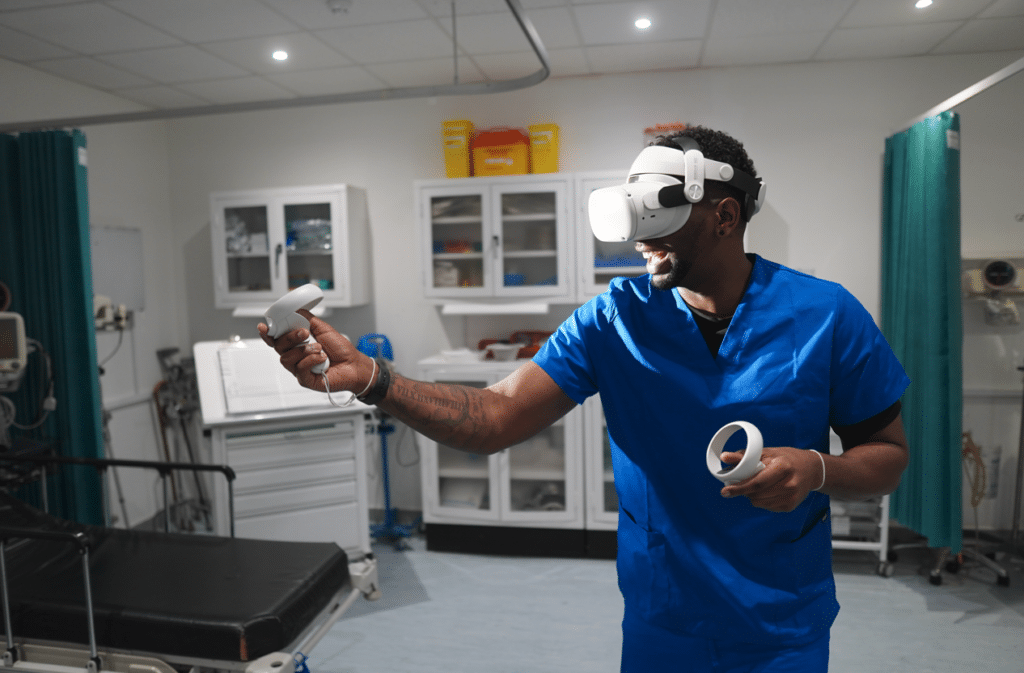Ready to step into the wide world of virtual reality simulation?
Need help kicking off your search to find the best VR healthcare company for you?
Starting to update or progress an educational or training program can feel daunting. But, with the right partner, it can feel like you’ve got a knowledgeable guide. They will help you find the best solution.
Suppose you know you’re searching for VR healthcare companies that can positively impact patients and reduce costs.
Even if you already have knowledge about the potential impact of using VR for education or training, there’s still a significant amount of information out there. You may not be sure what criteria will make a difference to your decision-making process.
From ensuring alignment with learning objectives to implementation and support to content fit to feasibility, finding what will work best for you and your learners can feel like a daunting task.
That’s why we’ve created this guide—to give you a sense of what to look for and how to select the right VR partner!
Alignment with objectives
What’s the first thing you want to know about your future VR partner? Whether their product fits your needs and learning objectives!
If you’re searching for a maternal health scenario, for example, but the VR vendor doesn’t offer that area of care, it’s fair to say that vendor probably won’t be best for you.
On the flip side, if you don’t have your learning objectives established yet, it can be hard to discern whether or not the vendor has what you need. So before you get started in speaking with potential candidates, make sure you know a bit about:
- What your learners will be using VR for
- What the learning objectives are for your course or program
- Which modality fits best for your learners
Consider whether this will be used for first-year nursing students or practicing clinicians. The level of difficulty should be suitable for the people who will be engaging with the simulation.
What do you expect learners to get out of this simulation? Do they need to demonstrate clinical decision-making skills, conduct a procedure, or take a patient history? These needs may change which type of scenario you choose and can play a part in determining the suitable modality for your learners.
For example, a hand interaction scenario may be more appropriate if you expect learners to demonstrate a skill like PIVC insertion. Or, if you want learners to collaborate on a case, multi-participant may be right for you.
Do you want your learners to develop rapport and speak directly with patients? A voice-control scenario may make the most sense.
Allow your learning objectives to help guide you in narrowing down your options and determining which one or set of scenarios will be best for your learners.
This is an area that your VR vendor should have significant knowledge about, and they should be able to consult with you to determine which type of simulation will work best. Questions you can ask here include:
- My learning objectives are XYZ. Which type of simulation would you recommend?
- How can I determine how learners are meeting the objectives of this simulation?
- Which scenarios will be better for newer students, and which will be better for advanced learners?
Questions like the above can provide a wealth of information about your potential partner’s expertise in the industry.
Do they deeply understand who your learners are and where they’re trying to go? Can they provide multiple opportunities for meaningful learning experiences tailored to your learners’ skill levels and goals?
When asking questions like these and working to determine the right fit, you must walk away feeling like you have a collaborative, responsive, and knowledgeable partner who will help guide you along the way.
Implementation and support
The next question in your mind likely revolves around the practicality of it all – how will it all work? Questions like:
- Who will be responsible for the implementation process?
- What support can you expect during the process?
- How will you efficiently get VR into learners’ hands?
The best VR healthcare companies will clear a path to make it as easy as possible for you and your staff to successfully and efficiently onboard learners or other faculty.
A good VR partner will help you get everything set up, but a great VR partner will go beyond that. They will continuously check-in and provide ongoing support to you and your learners—not just at the beginning but throughout the entire process. This commitment to support will make you feel cared for and supported in your journey.
It may help you to know more about the following:
- The number of learners you will onboard
- The impact you want to have
- When you want or need to have it all up and running
- How you will receive notices of updates or new features
Here, you may also want to know more about the steps your VR partner will take – or recommend you take – to ensure the security of your learners’ information. How will it be maintained? How will you support protecting and securing your learners’ personal information?
These processes are likely already established, but it would be helpful for you to know before moving forward.
Additionally, you may already be thinking about how VR use can be expanded over time within your institution. If so, consider asking more about how scalable the system is. Can you quickly broaden its use to a larger cohort as your implementation of VR grows?
Asking VR healthcare companies about their support during and after implementation can help save you time (and technological headaches!).
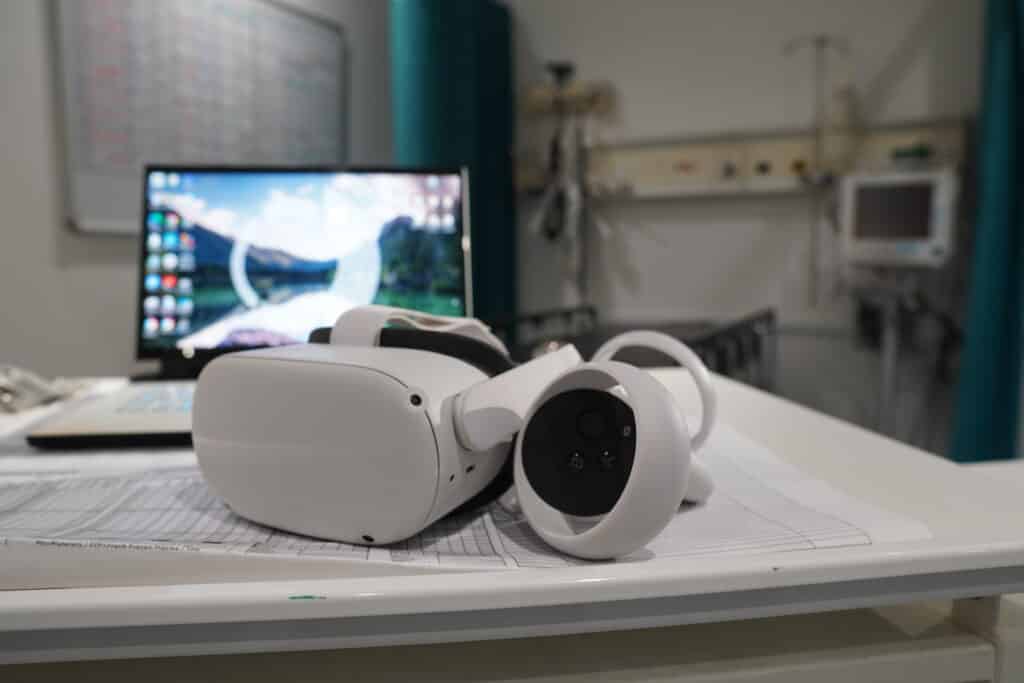
Flexibility
One key reason for choosing VR is its flexibility! Your VR partner should be flexible in their product and in accommodating your specific needs.
Consider who you’ll want to supervise your learners (if anyone), where you’d like them to engage with VR, and the types of scenarios your learners can use to develop more targeted clinical skills.
Can learners engage solo and with supervision?
Do you want your learners to use VR only when a colleague or faculty member is present? Or do you want them to be able to access simulations anytime, remotely, and anywhere, with or without a supervisor?
If you’re looking to deliver VR simulation to a large number of learners or to use VR simulation remotely, finding a solution that provides automated scenarios and feedback is vital.
In addition to removing scheduling barriers, automated scenarios provide unlimited repeatability, allowing your learners to grow their skills through as much self-directed practice as they need.
It also allows them to practice alone before leading cases in front of their peers, ensuring psychological safety. So, it’s worth considering how important this is to you early in the process.
Does it work on screen and in VR?
Consider where and when your learners will be able to access these scenarios. If you’re looking for more flexibility, you may want to consider a VR healthcare company that caters to virtual reality and on-screen simulations.
Some people may not be able to use VR due to several factors. Providing on-screen simulations in addition to VR can serve as an alternative solution for those learners, ensuring accessibility for those who otherwise would not be able to participate.
The flexibility of both VR and on-screen scenarios also grants learners access to simulations at home – even if they don’t have a VR headset – to further increase your ability to scale simulation remotely.
How flexible is the team?
Finally, flexibility isn’t just about the product; it’s also about the team—a flexible team can accommodate your time, develop creative solutions, advise on the best ways to implement, and remain available for any questions.
Consider what support you might need throughout the decision-making and implementation process. Do you need curriculum or implementation advice? Do you want to hear who the company has partnered with before? Do you need a demo to ensure you’re happy with the product?
Asking yourself questions like these will give you a sense of the kind of experience you’re looking for, what impact you’re looking to create, and how flexible your VR partner should be.
Quality
One key feature you’ll likely be interested in to know more about across VR healthcare companies is the quality of their scenarios.
How realistic is it?
First, VR simulations should feel real – they should be dynamic, feature realistic characters, and have robust narratives.
Some virtual platforms have linear or branching scenarios – similar to a choose-your-own-adventure – but this simplicity isn’t how clinicians and patients operate in the real world, so always ask a potential VR partner about how their scenarios function.
Consider asking questions like:
- Are there multiple paths through a scenario?
- Can you multitask?
- Can you see the effects of illness or treatment in a patient?
- Is the patient’s conversation, behavior, and physiology adaptive?
All of these factors increase the realism of the experience, so it’s ideal that your VR partner considers these elements when creating their scenarios.
Real practice isn’t always step 1, then step 2, then step 3, so it shouldn’t be that way during a simulation. There isn’t only one path to complete a scenario correctly; if you want your scenarios to flow like real life, you are looking for a non-linear flow.
This means that mistakes beget consequences, and effective treatment visibly improves the patient’s state—the simulation won’t stop you just because you’ve made an error.
In fact, you may seek out scenarios that allow mistakes to play out so learners can safely experience what it looks like when things go wrong.
Patient states should ebb and flow, too – just as in real life. Pallor, respiratory rate, clamminess – these things change in patients and can fluctuate within hours, minutes, or even seconds. That’s exactly how a patient’s physiology should be in a VR scenario – dynamic.
Finally, patients don’t always say what you expect them to say. They’re people with emotions, and sometimes people have bad days. Do your VR scenarios reflect that? Can your virtual patients change emotions, and can those emotions shift based on how your learner interacts with them?
It’s crucial to reflect real life as much as possible in simulation, so getting a deep understanding of the components that go into creating a realistic scenario can help you ensure that your learners are practicing in a way that directly reflects the clinical setting.
This delivery of functional fidelity and narrative depth is what allows OMS scenarios to feel natural and remain non-linear, ensuring that experiences can play out in many ways. It’s all up to your learner to direct the situation and act accordingly!
Are scenarios aligned with best practices?
To simulate comprehensive, realistic clinical situations, scenarios must be grounded in current evidence and best practices. Beyond the scenarios themselves, peer-reviewed feedback can provide a meaningful basis for tracking progress and competency.
To determine the level of expertise involved in the scenarios, you may want to inquire about how VR healthcare companies create new scenarios.
Are they created in-house? By a team of experts with experience in the field?
Importantly, do scenarios undergo a peer review process before publication to ensure they’re accurate and aligned with best practice standards?
Fidelity in simulation isn’t necessarily enough, so make sure your VR partner explains how they create scenarios and whether those scenarios are based on the latest evidence.
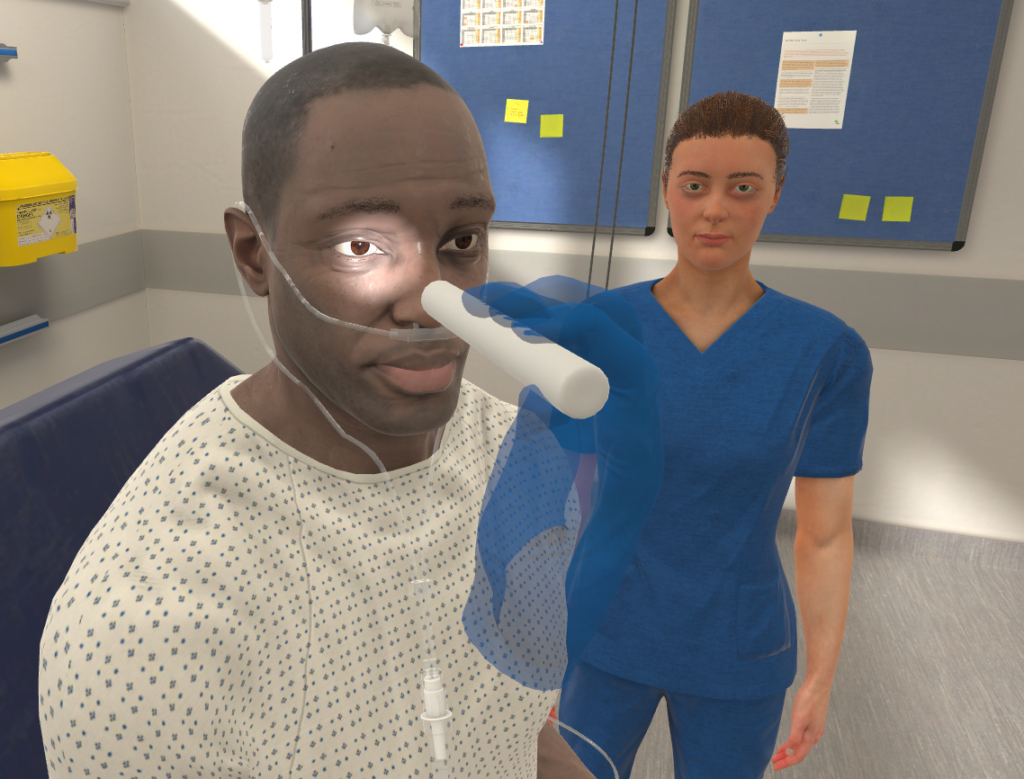
Breadth of content
What specialties are covered?
You may need your learners to gain experience or increase their practice in different settings or conditions. Perhaps your learners plan to work in the inpatient or outpatient setting, or maybe you need them to have experience in both maternity and pediatric care.
Exposing learners to various areas of care can make all the difference, especially as many students simply cannot lead care during infrequent, emergent situations – many more may only experience these situations once they unfold during practice.
Providing opportunities for learners to refresh skills or recognize signs of an emergent condition can help build confidence and competence when these situations inevitably arise.
Consider asking your potential partner about their scenario libraries. Which areas of care do they cover? What do they not cover?
Think about the level of difficulty your learners need. Will you be using these scenarios with both beginners and advanced learners? If so, consider asking more about levels of difficulty that can be adjusted or which scenarios your partner recommends for particular skills.
The right VR healthcare company for you is likely to have existing scenarios that reflect the content you’re looking for.
If they don’t, you may want to know about the possibility of a partnership to create a custom plan with bespoke content that fits your needs.
Can you do individual and team training?
Think about how important it is for your learners to go into scenarios alone and with others.
Just like you would expect in the clinic, independently driven scenarios place the learner in the position of directing patient care. The learner works independently, focusing on clinical reasoning, critical thinking, and decision-making through deliberate practice.
If you’d also like your learners to be able to work together in simulations, consider whether your VR partner offers multiplayer scenarios.
In these scenarios, at least two learners – across disciplines – are working together to provide timely and effective patient care.
In simulations with multiple participants, you may want to know more about how the feedback will change between individual and interprofessional scenarios, as multidisciplinary scenarios require additional skills like teamwork and communication.
Can you see multiple patients at once?
Clinicians rarely care for one patient at a time, so consider if the VR healthcare company you’re speaking to provides multi-patient scenarios to help your learners prepare for practice more effectively.
These scenarios are typically for more advanced learners preparing for the transition to practice or onboarding as new graduates.
The ability to treat multiple patients at once provides an insightful, meaningful learning opportunity that most students in a healthcare program will not get the chance to do in their capacity as students.
As learners handle these dynamic simulations, they’ll have the chance to work on care prioritization and reprioritization, multitasking, delegating, and patient and interprofessional communication to effectively manage the complex nature of healthcare practice.
Consider whether you’ll want to scaffold skills in increasingly complex scenarios and ensure your VR partner provides this opportunity to your learners.
Can you teach procedures and communication skills?
Ask your potential VR partner if they can also build out other types of scenarios. This includes scenarios with hand and voice control, not just single-player vs. multiplayer or single-patient vs. multi-patient.
For instance, procedural scenarios use hand control to allow for repeated practice in technical skills. They enable the learner to develop much-needed muscle memory for a particular skill or procedure, with vibrotactile haptic feedback to simulate any level of interaction.
Scenarios using voice control require learners to speak with a patient and the team to gather information, convey empathy, educate, or de-escalate as needed.
As voice and hand control add layers of complexity and cognitive load to scenarios, the possibilities are seemingly endless (and even a bit overwhelming)! Your VR partner should help you understand the options available so you can make an informed decision about what types of scenarios will best serve your learners.
Having various options is important in tailoring the learning experience as much as possible, so be sure to ask about the breadth of content and the modalities offered.
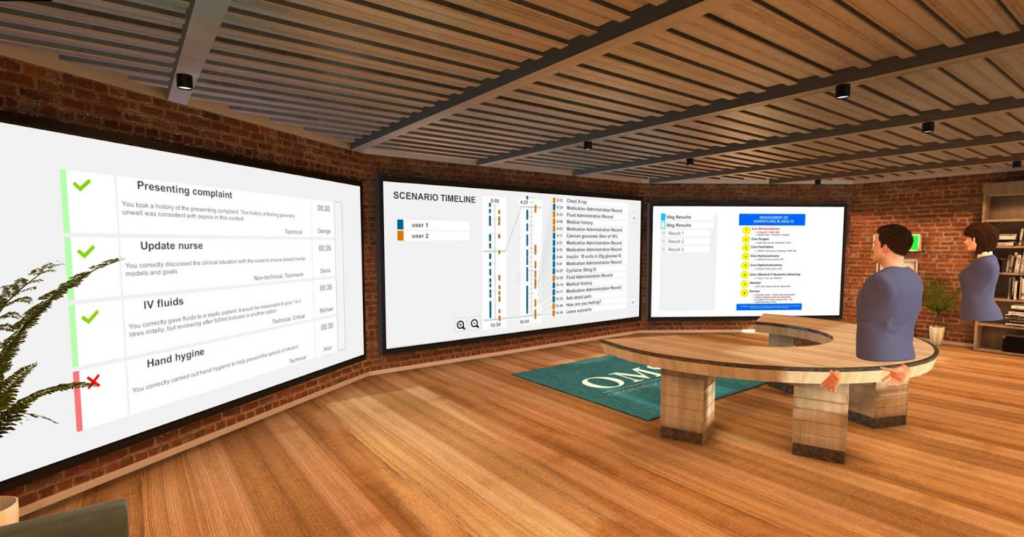
Data & analytics
Providing meaningful feedback is an essential part of any simulation. You may be looking for VR healthcare companies with a platform that provides instant feedback to learners and delivers performance data in an objective and standardized way.
What feedback do learners get?
Ask yourself if you want the feedback your learners receive to provide evidence-based, unbiased advice to help them improve after every scenario.
What about the ability to use your VR platform to benchmark performance or even to be used for formative and summative assessments?
Automated feedback that provides supporting evidence to maintain alignment with standards of best practice can help your learners self-reflect immediately after the scenario.
With appropriate feedback, learners can easily identify mistakes or areas for improvement while better understanding their clinical performance overall. They can then immediately put that feedback into practice by running through the scenario again.
Staff can also use feedback to facilitate a meaningful debrief by identifying common mistakes amongst learners, recognizing trends, or discussing key takeaways from the scenario.
Consider asking about how feedback is generated for learners and if it aligns with current best evidence, so you rest assured your learners are getting quality feedback that they can use to improve their clinical practice.
What analytics are provided?
Another critical feature to discuss with your future VR partner is what types of insights you can expect to gain from partnering with them.
If you want to tease it out in more detail, ask:
- Do they have an objective scoring system?
- Can you track learner improvements over time?
- Can analytics be linked with learning management systems?
- How are learners scored in this system?
You may also want to ask how these VR companies recommend using data provided by the platform. An experienced team should be able to discuss how the analytics are being used to create a positive impact for learners and staff.
Depending on your chosen partner, you may have access to all sorts of information and insights. A clinical performance score, for example, may tell you more about the actions learners take in the scenario, what they prioritize, and the time between observations and the initiation of treatment.
Access to detailed analytics can provide you with a support network for making data-driven decisions about your curriculum or training program.
Your VR partner should be able to discuss the data you can expect to see, who can view it, and how it can be used most effectively to bolster your learners’ knowledge and track their progress over time.
Do scenarios link with competency frameworks?
Your scenarios must be evidence-based. While simulation itself can be a promising tool for promoting competencies, it can be challenging to implement virtual reality simulations that track progress in a way that aligns with current competency frameworks.
For example, if you wanted to see how your learners are progressing towards their preparation for the Next Gen NCLEX in the OMS platform, you would be able to see data about how often your learners are taking actions within a scenario that aligns with each core competency.
Health promotion and maintenance, physiological integrity, psychosocial integrity, and safe and effective care each have their own insights, meaning you can easily view where your learners are performing well and where there’s room for improvement.
The ability to use immersive scenarios and access meaningful feedback can be immensely valuable in ensuring your learners are on the right track. Your VR partner should be able to explain that data and how it can benefit your program.
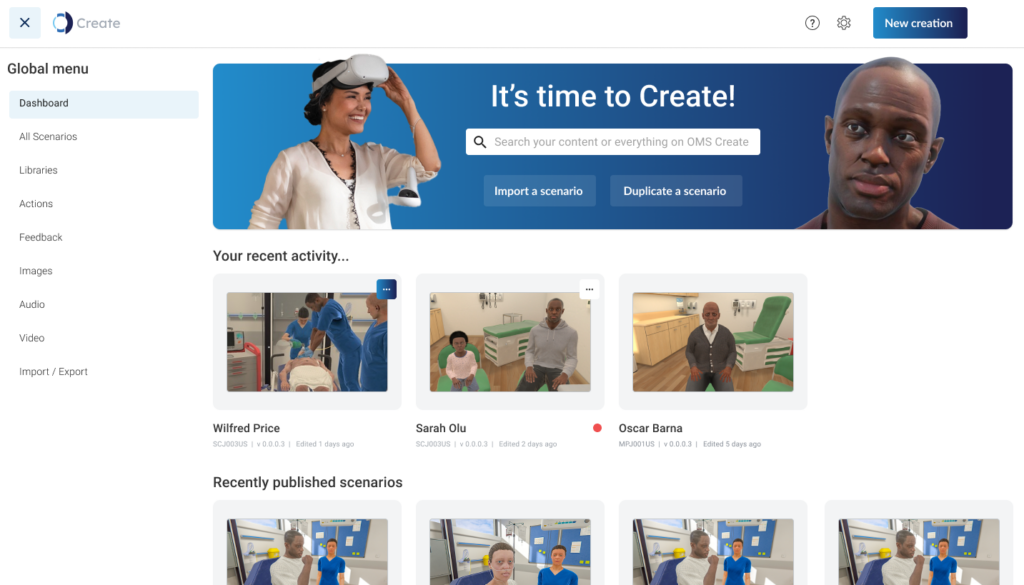
Customization
What can I do with your authoring platform?
Is it essential for you to be able to customize scenarios to meet specific needs? If so, you may want to work with a VR healthcare company that houses an authoring platform.
Think about the level of control you’d like to have when you author. Are you looking to make small adjustments to existing scenarios by changing vital signs, lab results, or patient conversation? Or are you looking to build new scenarios from scratch?
Suppose you are creating VR nursing simulations for onboarding purposes, for instance. In that case, you may want to have a platform that allows you to upload your facility’s protocols so you can be sure your newly hired nurses are becoming familiar with exactly the right steps to take on the floor.
Perhaps you need a virtual patient to appear unwell more quickly, or you want to add documentation to your virtual patient’s medical record. If having the freedom to create is important to you, be sure to ask about the capabilities of any authoring platform you’ll have access to.
Do you offer bespoke partnerships?
In working with your VR partner, could you truly partner with them?
In addition to authoring platforms, if you’re looking to grow your VR capabilities as an institution, it’s worth asking if you can engage with your partner on custom content, quite literally designed to fit your needs.
Ask:
- Have you partnered with other institutions?
- What were the outcomes of those partnerships?
- How does the process work?
You can even request to be introduced to existing clients and partners for reference checks – you need to make sure they’re right for you!
Budget
How does pricing work?
As with any new venture, cost is always a factor, and you’ll likely consider your price when talking to VR healthcare companies.
It may be helpful to have a range that you’re comfortable with. This can help you shop around to determine what solution will ultimately give you the most for your money.
A knowledgeable partner can provide you with more information on the pricing structure and the expected start-up costs for implementing VR into your sim program.
You may expect to reduce costs with VR, so ask what you should expect from initial setup and maintenance costs over time.
A VR partner should bring knowledge to the table and ease your mind by explaining all the steps you can expect to take throughout the process.
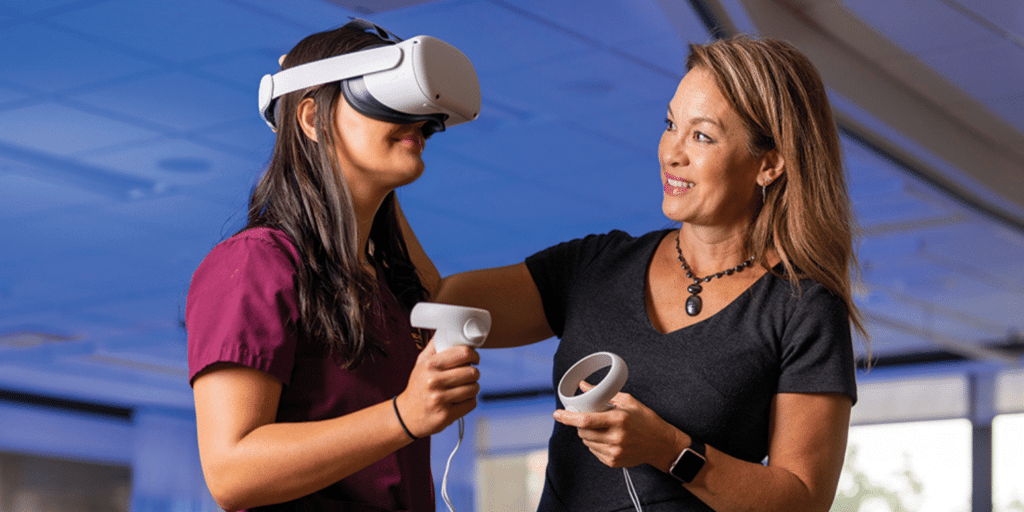
Finding your VR partner
All things considered, you’re probably looking for a VR partner that can:
- Inform you about VR – in general, and how it relates to your curriculum
- Provide flexibility in pricing or structuring
- Produce quality content and meaningful data
- Maintain open communication and support throughout the process
Experience & Expertise
Coming from the healthcare world, you want to work with a VR partner that has a team of people who understand healthcare and VR simulation. Look at who makes up the team—are there clinicians and simulationists? It may be necessary for you to have people who can understand both!
Take stock of how you feel in these initial conversations. Does their expert understand your specific needs and goals? Are they answering questions you didn’t even know you had? Is ongoing support included in your package?
Content Fit
Ensure that the scenarios meet your requirements and expectations. Consider the VR vendor’s current list of simulations, if they’re evidence-based, what their future scenarios look like, and if they can create custom content that meets your needs. Ask if you’ll be able to take advantage of any upcoming developments.
Data & analytics
When speaking with a VR partner, you should understand the data you can expect to see and how you can use it to assess learners’ progress and promote competency.
Support
A true partner walks the path with you; communication is vital to maintaining a good partnership. Your VR partner should be responsive and help you troubleshoot any issues along the way, virtually or onsite. Success and support teams should be ready to help you whenever you need it – not just when you’re starting but throughout your entire experience.
For more information
Conversations with the right VR healthcare company should feel like talking to a trusted confidante about your challenges and how you can work together to address them. The right VR partner should work with you to develop the right plan to fit your needs while keeping in mind your budget.
To get a sense of what you can expect when partnering with OMS, send us your questions or schedule a call with an experienced Educational Specialist.
——————————–
A resource just for you!
Phew, what a read! You’ve made it all the way through this guide—now what? Start by grabbing the checklist of relevant questions, which you can edit and take with you to your next meeting!
